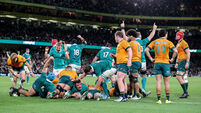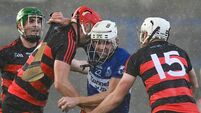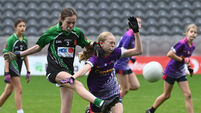Jack Anderson: Buy and wear a proper hurling helmet. You can thank me later

ESSENTIAL GEAR: The helmet set aside - but only for the Kilkenny Tipp warm up. Pic: James Crombie, Inpho
Forty years ago, the Grand Slam-winning Wallabies gave us a glimpse of the future of rugby.
Wingers who got the ball, props who wanted the ball and a fly half (Mark Ella) who passed it. Looking back on that Australian rugby tour to Britain and Ireland, you can see how much rugby, and Ireland, has changed.
The Wallabies played 18 matches on that tour. Ulster, with a team that would form the basis for Ireland’s Triple Crown the following year, beat them on a dank Ravenhill day (is there any other?) in mid-November. A couple of days later Margaret Thatcher would give her famous “out, out, out” speech. A month earlier, the IRA had nearly assassinated her with the Brighton bombing.
The Wallabies toughest run in 1984 was in Wales. Welsh club rugby was then highly competitive: Llanelli and Cardiff beat Australia; Pontypool and Swansea were more competitive against them than the national team.
Central to the Wallabies’ success, which sparked two decades of unprecedented success for them, was their coach, Alan Jones. On return from that tour, Jones began a long and lucrative career as a talkback radio host in Sydney.
A “shock jock”, he bullied politicians, and, at times, seemed not just to set the political agenda but to be the political agenda in Australia.
His shadow continued to loom over Australian rugby, and as late as 2007 he was reapplying for the national job.
Jones particularly despised Australia’s first woman prime minster, Labour’s Julia Gillard. In an address to the University of Sydney Liberal Club in 2012, Jones was recorded as saying that Ms Gillard's late father “died of shame” because of his daughter's political “lies”.
A man who made millions from words, then ate them, and apologised. In 2019, he was at it again, urging the then Australian prime minister Scott Morrison to “shove a sock” down New Zealand PM Jacinda Ardern's throat.
By then, key advertisers had deserted him and while not quite ever becoming the Abe Simpson meme of “Old Man Yells at Cloud”, the impact of his vitriol was much diluted. The Australian word of the year for 2024 is enshittification – the gradual deterioration in the quality of a service as it chases lazy profit. Jones, over the last few years, epitomised it.
Last week, the now 83-year-old Mr Jones was charged on 26 criminal counts including offences of aggravated indecent assault, involving nine alleged victims. NSW Police, whose investigation is continuing, say that Jones knew the alleged victims (the youngest of whom was 17 at the time the alleged offence occurred) personally and professionally.
The alleged victims are all men and reportedly include several former athletes. Jones’ first formal court appearance will be in Sydney in mid-December, exactly 40 years since he coached the Wallabies to a win against the Barbarians in Cardiff.
Although the seriousness of the charges is eye-catching, and will, if proven, attract significant jail time, you cannot say, from reading the domestic press, that allegations of this nature against Jones are entirely shocking for Australians.
Jones, it appears, wasn’t necessarily liked nor even respected by his former players (Ella who retired at 25 after the 1984 Tour said this week that one year of “AJ” as a coach was enough) or radio staff or colleagues but he certainly was feared.
Something that did however genuinely shock the Australian sporting world occurred a decade ago this week. A first class cricketer Phillip Hughes was struck by a bowled ball in the neck while playing at Sydney Cricket Ground on 25 November 2014.
The freakish, accidental manner in which the ball landed burst an artery in Hughes’ neck causing a brain haemorrhage. Hughes died two days later.
Hughes was a country boy, and unusually now in the world of elite professional sport in Australia, not a private school boy. He was a farmer, an easy-going but determined and popular player. One of the national selectors wrote this week about how during the many gaps in play in cricket, he loved talking about his farm and that the last conversation the selector had with Hughes was about AI - insemination not the technology.
The subsequent coroner’s investigation into Hughes’ death was a fraught affair, with allegations that players on the opposing team had “sledged” Hughes and deliberately targeted him with bouncers to the head.
These allegations were never substantiated and the coroner concentrated on the emergency response on the day and future safety equipment enhancements for the sport. Now players at all levels of cricket wear a simple neck guard clipped to the rim of their helmet.
Incomprehensibly, some leading Australian cricketers until recently refused to wear the neck guards, citing restricted viewing, claustrophobia and discomfort as being reasons not to modify their helmets. Last year, Cricket Australia had to mandate that they do so.
The GAA also has mandatory rules about standard helmets in hurling and camogie, introduced in 2010. Prior to this, 51% of hurling injuries related to the facial area now protected by the helmet.
Since the introduction of the mandatory rule, injuries to the protected area have fallen to 5%. And yet, research by UCC and the Cork University Hospital researchers published earlier this year in the Irish Medical Journal highlighted that the use of non-standard helmets remains prevalent and that the players who wear such helmets carry a greater risk of injury and, strictly under policy, may not be fully insured when they play.
The researchers suggested that the GAA and Camogie Association might consider pre-game checks of player equipment as a means of eradicating poor equipment use.
For anyone who currently has or is playing with a non-standard helmet, the free advice from this sports lawyer is simple – read the tribute penned by Phillip Hughes’ parents issued this week on his 10th anniversary and then go buy yourself and play with a standard helmet.
Serious incidents are thankfully rare in sports such as cricket, camogie and hurling but they can and do occur and if you are not wearing the proper sports equipment you may not be compensated for your loss: try convincing an insurance company that not being able to see the ball properly was your excuse for wearing defective equipment and see how far it gets you.
So, just do it. Take personal responsibility for it.
A referee or other official on the day of a game should not have to do it for you. Buy the mandated IS:3EE helmet, don’t modify it, and tell your teammate who has the helmet with a facial guard as wide as car wing mirrors to ditch theirs.
Your teeth, your face, your sport, and your family, will thank you.











